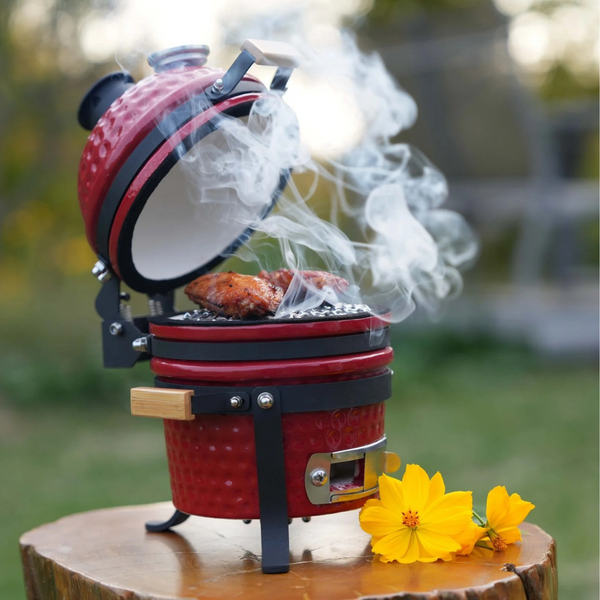
How Humidity Affects Charcoal Performance: A Griller's Guide
The Unseen Enemy of Your BBQ
Picture a perfect day for grilling—ideal weather, great company, and your meal prepped for the coals. But there’s one invisible factor that can turn that dream barbecue into a struggle: humidity. For many grillers, humidity and charcoal are an underappreciated challenge. Charcoal’s porous structure means it eagerly absorbs moisture from the air, especially in humid conditions, and this can derail everything from lighting the fire to maintaining even heat and rich smoky flavor.
This guide explores how charcoal moisture content impacts your cook, from ignition to burn efficiency and taste. You’ll also find practical charcoal grilling tips and storage suggestions so you can grill in humid weather without missing a beat. At Vessils, we believe mastering your fuel is as crucial as choosing the right grill.

The Science Behind Moisture Absorption
Charcoal is fundamentally carbonized wood, made up of countless microscopic pores. This makes it exceptionally absorbent, acting like a sponge and pulling in moisture from its environment—anywhere the relative humidity is high.
Equilibrium Moisture Content
-
Charcoal will absorb water until it balances with the air’s humidity, even when stored in what seems like a dry place.
-
This trapped water won’t chemically alter the charcoal, but it does physically interfere with burning by introducing moisture into your fuel bed.
How Humidity Impairs Charcoal Performance
Difficulty Lighting
-
Energy Drain: When charcoal is damp, your fire spends initial energy evaporating moisture before real combustion starts. That means longer lighting times and inconsistent ignition.
-
Visual Cues: Excessive white smoke, sizzling noises, and reluctance to ash over evenly signal wet charcoal performance issues.
Reduced Heat Output & Inconsistent Burn
-
Lower Calorific Value: Moisture dilutes the charcoal’s fuel potential, giving off less heat per chunk.
-
Uneven Combustion: Dampness creates “cold spots” within your coals, making it tough to maintain even temps—especially critical for direct vs indirect cooking on a charcoal grill.
-
Temperature Control Issues: Managing a kamado grill’s heat becomes trickier when moisture undermines charcoal burn efficiency (How to Control Temperature in a Kamado Grill).
Increased Smoke & Off-Flavors
-
Incomplete Combustion: Wet charcoal burns “dirty,” with more smoke and soot, possibly leaving unwanted bitter, acrid notes that mask the natural smoky flavor charcoal should impart.
-
Shorter Burn Time: Because energy is wasted evaporating water, damp charcoal burns out faster, so you’ll need to refuel more often.
-
Briquettes at Risk: Charcoal briquettes can crumble or clump due to humidity, as binders and fillers degrade when damp.
Identifying and Addressing Wet Charcoal
Visual Inspection
-
Damp texture, heavier feel, visible mold, and a thud rather than a “clinky” sound when jostled are all signs of wet charcoal.
Drying Methods
-
Air Drying: Spread charcoal in a sunny, well-ventilated spot for a few days to restore its performance.
-
Accelerated Drying: Carefully warm charcoal in a low oven or near a safe heat source. Exercise caution to avoid fire hazards.
-
Lighting Aids: Use a natural fire starter or a charcoal chimney (All Accessories) to help ignite slightly damp charcoal, but always focus on drying as a primary solution.
Optimal Charcoal Storage in Humid Climates
Airtight Containers
-
Store your charcoal in sealed, airtight bins made of heavy-duty plastic or metal to keep moisture at bay.
Cool, Dry Location
-
Place bins in garages, sheds, or pantries that stay naturally dry. Avoid direct sunlight or areas prone to high humidity.
Avoid Opened Original Bags
-
Once opened, original packaging offers little protection. Always transfer leftover charcoal to airtight containers.
Elevate Storage
-
Keep bins off concrete or stone floors, as these can wick up moisture. Use a shelf or pallet if possible.
Consider Desiccants
-
Add silica gel packets or moisture absorbers to containers to further reduce risk in extremely wet weather.
Master Your Fuel, Master Your Grill
Humidity and charcoal don’t have to spoil your BBQ plans. By understanding how charcoal moisture content impacts ignition, heat, and flavor—and storing your fuel wisely—you’ll enjoy consistent results every time you grill in humid weather.
Ready to perfect your grilling setup? Explore the full range of Vessils grills and accessories for quality equipment, and don’t miss the Recipes Blog Hub for dishes that shine when the heat is just right.
